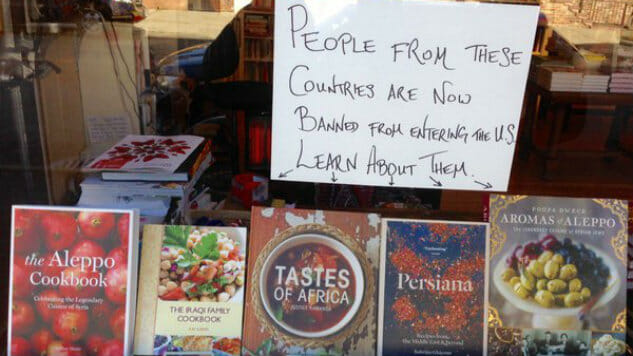Omnivore Books Highlights Banned Countries’ Cookbooks
Photo courtesy of Omnivore Books Food Features Cookbook
After newly-elected president Donald J. Trump issued a travel ban last month against seven Middle Eastern and African countries, one San Francisco bookstore decided to do something about it.
Omnivore Books owner, Celia Stack, began putting cookbooks from the seven banned countries (Syria, Sudan, Yemen, Iraq, Iran, Libya, and Somalia) on a prominent window display. A handwritten sign reading, “People from these countries are now banned from the U.S. Learn about them,” was taped above the display.
“It hit especially close to home when she thought about the authors who’ve come to speak at the shop who might not be allowed into the country because of (the ban),” Sarah Henkin, the shop’s manager, said of Stack. “In a fit of emotion, she picked out books that were written by authors from those countries to put on display.”
Photos of the store’s window display have gone viral on social media. The bookstore’s tweet, from January 28, has been shared over 1,200 times and has received over 2,400 likes on Twitter.
“We were heartened by the almost immediate reaction on social media and the conversations,” Henkin, said. “We also had a positive reaction from people on the street who noticed the window and stuck their heads into to say they liked it.”
The store, which sits in the heart of San Francisco, specializes in selling antiquarian and new books about food and drink. It also hosts events which feature chefs and authors.
The sign and accompanying display haven’t negatively impacted business. But that’s probably to be expected in a city as liberal as San Francisco.
“We did have a little bump for those books—including a neighbor who bought copies of each book for the elementary school she works at,” Henkin said.
The ban, meanwhile, has been put on hold by an appeal court decision to uphold a lower court’s restraining order. But the Trump administration has vowed to press on. Trump recently tweeted that he’d see the opponents of the ban in court.
Two of the cookbooks feature the cuisine of Aleppo, Syria’s largest city. Much of Aleppo has been destroyed in the five-year civil war that has torn the country apart. The city is one of the oldest in the world and sits along a near-timeless trade route that was an ancient Mediterranean crossroads, which shows in its cuisine.
The Aleppo Cookbook was written by celebrated Lebanese chef Marlene Matar, who has lived in the city and has Syrian ancestry on her mother’s side. It hit bookshelves this past October. It has recipes for much of what the city is known for. There are stuffed-vegetable dishes, like zucchini with beans in a spiced tomato sauce. One of the city’s staple foods is kibbeh, a sort of meatball stuffed with bulgur. Flat breads, such as Khobez Arabeh, are popular, as well.
The second Syrian cookbook featured in the window display is Aromas of Aleppo. The book is a thick tome that highlights the cuisine of the city’s former Jewish community. It was written by Poopa Dweck, an expert on Aleppo Jewish customs and cuisine, and debuted on bookshelves in 2007. Besides the kibbeh and stuffed vegetables, the book is an encyclopedia of meze—think Spanish tapas, Middle Eastern style. Aleppo is perhaps best known for muhamarra, a spicy red pepper, and nuts sauce, which features prominently in the book, as well.
Meanwhile, Persiana, written by Sabrina Ghayour, celebrates Iran’s cuisine. Iran is a country of 77 million, and it is famous for its rich and ancient cuisine. It’s reputed to even be the birthplace of ice cream. One of the hallmarks of Iranian cuisine is cooking fruit into meat dishes. One of the most famous of these dishes is fesenjan, a chicken stew made with pomegranate molasses and walnuts.
The book, which came out in 2014, features many recipes with sumac, a popular middle eastern spice that is made from the berries of the sumac bush. It gives off a slightly tart, lemony taste and shows off a deep red color.
Three of the seven banned countries are in Africa (Libya, Sudan, and Somalia). Tastes of Africa by Justice Kamanga, which came out in 2010, has recipes from all three, vastly different, nations. Libya, in North Africa, is known for couscous, a semolina-based dish, and for shakshouka, eggs poached in a spiced tomato sauce, typically eaten with a side of flatbread. Italy colonized the country for a number of years in the early 20th Century, and pasta is still served in Tripoli, the country’s capital.
In Sudan, the national dish is ful medames, a dish of cooked fava beans seasoned with cumin (it’s also the national dish of Egypt). The country is also known for its paper thin flat bread, called Kissra. Somali cuisine is known for its rice and banana dishes, called bariis. The country’s staple bread is called canjeero.
Lastly, The Iraqi Family Cookbook by Kay Karim features many kebab recipes, something that the Middle Eastern country has long been known for. The book, which first hit shelves in 2012, also includes recipes for lamb and okra stews, along with kleicha, a cooked stuffed with dates that is one of the country’s most popular cookies.